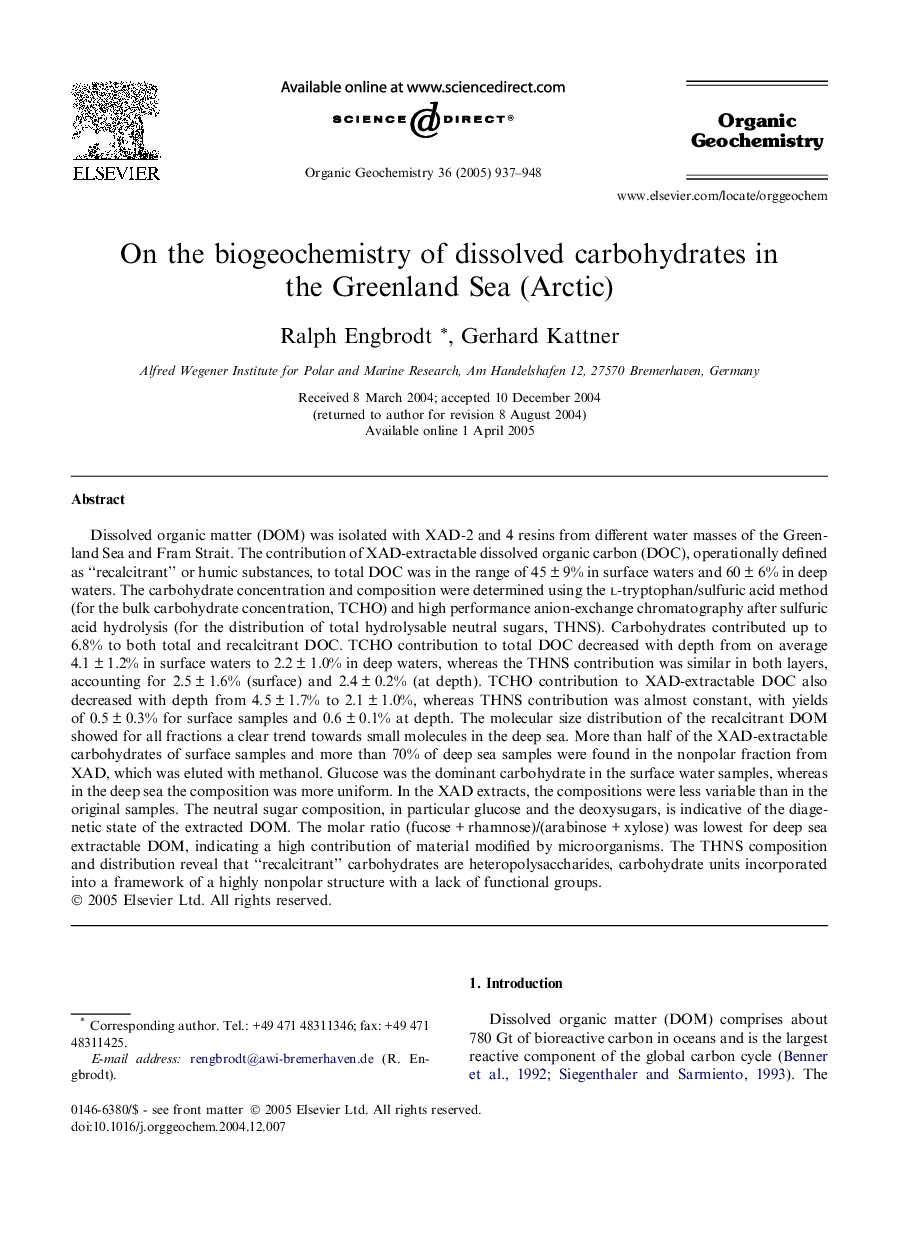| کد مقاله | کد نشریه | سال انتشار | مقاله انگلیسی | نسخه تمام متن |
|---|---|---|---|---|
| 9556840 | 1379902 | 2005 | 12 صفحه PDF | دانلود رایگان |
عنوان انگلیسی مقاله ISI
On the biogeochemistry of dissolved carbohydrates in the Greenland Sea (Arctic)
دانلود مقاله + سفارش ترجمه
دانلود مقاله ISI انگلیسی
رایگان برای ایرانیان
موضوعات مرتبط
مهندسی و علوم پایه
شیمی
شیمی آلی
پیش نمایش صفحه اول مقاله

چکیده انگلیسی
Dissolved organic matter (DOM) was isolated with XAD-2 and 4 resins from different water masses of the Greenland Sea and Fram Strait. The contribution of XAD-extractable dissolved organic carbon (DOC), operationally defined as “recalcitrant” or humic substances, to total DOC was in the range of 45 ± 9% in surface waters and 60 ± 6% in deep waters. The carbohydrate concentration and composition were determined using the l-tryptophan/sulfuric acid method (for the bulk carbohydrate concentration, TCHO) and high performance anion-exchange chromatography after sulfuric acid hydrolysis (for the distribution of total hydrolysable neutral sugars, THNS). Carbohydrates contributed up to 6.8% to both total and recalcitrant DOC. TCHO contribution to total DOC decreased with depth from on average 4.1 ± 1.2% in surface waters to 2.2 ± 1.0% in deep waters, whereas the THNS contribution was similar in both layers, accounting for 2.5 ± 1.6% (surface) and 2.4 ± 0.2% (at depth). TCHO contribution to XAD-extractable DOC also decreased with depth from 4.5 ± 1.7% to 2.1 ± 1.0%, whereas THNS contribution was almost constant, with yields of 0.5 ± 0.3% for surface samples and 0.6 ± 0.1% at depth. The molecular size distribution of the recalcitrant DOM showed for all fractions a clear trend towards small molecules in the deep sea. More than half of the XAD-extractable carbohydrates of surface samples and more than 70% of deep sea samples were found in the nonpolar fraction from XAD, which was eluted with methanol. Glucose was the dominant carbohydrate in the surface water samples, whereas in the deep sea the composition was more uniform. In the XAD extracts, the compositions were less variable than in the original samples. The neutral sugar composition, in particular glucose and the deoxysugars, is indicative of the diagenetic state of the extracted DOM. The molar ratio (fucose + rhamnose)/(arabinose + xylose) was lowest for deep sea extractable DOM, indicating a high contribution of material modified by microorganisms. The THNS composition and distribution reveal that “recalcitrant” carbohydrates are heteropolysaccharides, carbohydrate units incorporated into a framework of a highly nonpolar structure with a lack of functional groups.
ناشر
Database: Elsevier - ScienceDirect (ساینس دایرکت)
Journal: Organic Geochemistry - Volume 36, Issue 6, June 2005, Pages 937-948
Journal: Organic Geochemistry - Volume 36, Issue 6, June 2005, Pages 937-948
نویسندگان
Ralph Engbrodt, Gerhard Kattner,